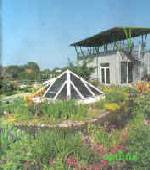|


Related Topics

| |
 Enhancing our
Environment Enhancing our
Environment
 Promoting Economic
Development Promoting Economic
Development
 Improving Human
Health Improving Human
Health
 Landscaping for the
Future Landscaping for the
Future
-
Plants protect water quality. Proper landscaping reduces nitrate
leaching from the soil into the water supply. Plants also reduce surface water
runoff, keeping phosphorus and other pollutants out of our waterways and
preventing septic system overload.
-
Proper landscaping reduces soil erosion. A dense cover of plants
and mulch holds soil in place, keeping sediment out of lakes, streams,
stormdrains, and roads; and reducing flooding, mudslides, and duststorms.
-
Plants improve air quality. One tree can remove 26 pounds of carbon
dioxide from the atmosphere annually, equaling 11,000 miles of car emissions.
Landscape plants, including shrubs and turf, remove smoke, dust, and other
pollutants from the air. One study showed that I acre of trees. has the
ability to remove 13 tons of particles and gases annually.
-
Landscaping lowers summer air temperatures. According to the EPA,
urban forests reduce urban air temperatures significantly by shading heat
sinks such as buildings and concrete, and returning humidity to the air
through evaporative cooling. Trees shading homes can reduce attic temperatures
as much as 40 degrees.
-
Landscaping conserves natural resources. Properly placed deciduous
trees reduce house temperatures in the summer, allowing air conditioning units
to run 2 to 4 percent more efficiently, but allow the sun to warm the house in
the winter. Homes sheltered by evergreen windbreaks can reduce winter heat
loss and are generally warmer than homes without such protection. By using
trees to modify temperatures and protect against wind, the amount of fossil
fuels used for cooling and heating is reduced.
-
Landscaping screens busy streets. Well-placed plantings offer
privacy and tranquility by screening out busy street noises and reducing glare
from headlights.
Return to Table of Contents
-
Landscaping increases property market value A 1991 study estimates
that an attractive landscape increase the value of a home by an average of 7.5
percent, and reduces the time on the market by five to six weeks. The Wall
Street Journal reported that landscape investments are recovered fully, and
sometimes doubled, by the increased home value.

-
Good landscaping increases community appeal Parks and street trees
have been found to be second only to education in residents' perceived value
of municipal services offered. Psychologist Rachel Kaplan found trees, well-
landscaped grounds, and places for taking walks to. be among the most
important factors considered when individuals chose a place to live.
-
Landscaping reduces crime. In a California study, landscaped areas
were relatively graffiti-free, while open, nonlandscaped areas were graffiti
targets. Well planned and maintained landscapes are seen as safer than
unmaintained plantings.
-
Plants increase tourism revenues. Interior landscaping at the
Opryland Hotel in Nashville, Tennessee, is credited for an unusually high (85
percent) occupancy rate. Guests willingly pay an extra $30 per night for rooms
overlooking the jungle-like display, netting $7 million a year in additional
room revenues. The city of Virginia Beach attributes, in part, their $52
million in convention revenue for 1994 to the landscaping efforts of recent
years.
-
Views of plants increase job satisfaction. Employees with an
outside view of plants experience less job pressure and greater job
satisfaction than workers viewing man-made objects or having no outside view.
They also report fewer headaches and other ailments than workers without the
view.
-
Nature increases worker productivity. Psychologists have found that
plants and green spaces provide a sense of rest that allows workers with
access to plants and nature to be more productive.
-
Landscaping renews business districts. Greening of business
districts increases community pride and positive perception of an area,
drawing customers to the businesses.
Return to Table of Contents
-
Gardening is excellent physical exercise. Routine gardening tasks
such as shoveling, rototilling, and even mowing grass with a push-type, reel
lawn mower can measure up to the exertion rates of jogging, bicycling, or
aerobics. Studies have shown that one hour of weeding bums 300 calories - the
same as walking or bicycling at a moderate pace.

-
Gardens produce healthy food. Fresh food from the garden can have
up to three times as many vitamins and minerals as canned or frozen food.
Community garden plots have become a valuable means of providing food for the
homeless.
-
Horticulture is therapeutic Horticultural therapy is a treatment
for a variety of diagnoses. Working with and around plants improves quality of
life through psychological and physical changes. Nurturing a plant into
maturity from seed is rewarding and builds self-confidence. Various
horticulture-related tasks such as carrying plants, planting trees, or
arranging flowers are used to improve coordination and motor control of
injured or disabled individuals.
-
Landscapes heal. Restorative gardens offer an environment for
people who are sick, injured, and under stress to recover and regain
confidence in themselves. Such landscapes are also currently used by hospices
in treatment of Alzheimer and AIDS patients. Roger Ulrich showed through a
study of hospital patients that those whose rooms overlooked vegetation
recovered faster and required less pain medication than did patients without a
view of nature.
Return to Table of Contents
Landscaping is an integral part of our culture and plays an essential role in
the quality of our environment, affecting our economic well-being and our
physical and psychological health.
 If we are to keep our communities strong
and prosperous, we must take responsibility for our environment. Environmental
responsibility is a step beyond awareness, developed only through experience.
Through our gardens and landscapes, we acquire a personal awareness and
responsibility for the environment while we relieve the tensions and
frustrations of everyday life. If we are to keep our communities strong
and prosperous, we must take responsibility for our environment. Environmental
responsibility is a step beyond awareness, developed only through experience.
Through our gardens and landscapes, we acquire a personal awareness and
responsibility for the environment while we relieve the tensions and
frustrations of everyday life.
Landscaping offers many opportunities for the encouragement and education of
responsible, productive citizens. School grounds represent the world environment
of a child and should be designed and integrated into the curriculum to instill
responsibility, knowledge, and experience in caring for the environment, while
teaching the math, science, and art associated with the cultivation of plants.
Public and commercial landscapes have a major influence on our environment,
and on peoples actions and attitudes. Sustainable landscape maintenance
techniques can be used to protect the environment while enhancing economic
development and improving worker productivity.
Landscaping is one of the most cost effective tools for improving and
sustaining the quality of life, whether in the city, the suburbs, or the
country.
Return to Table of Contents
|
![]() Gardeners' Corner
Kids'
Garden
Sustainable Garden
Contact Us
Gardeners' Corner
Kids'
Garden
Sustainable Garden
Contact Us![]()






 If we are to keep our communities strong
and prosperous, we must take responsibility for our environment. Environmental
responsibility is a step beyond awareness, developed only through experience.
Through our gardens and landscapes, we acquire a personal awareness and
responsibility for the environment while we relieve the tensions and
frustrations of everyday life.
If we are to keep our communities strong
and prosperous, we must take responsibility for our environment. Environmental
responsibility is a step beyond awareness, developed only through experience.
Through our gardens and landscapes, we acquire a personal awareness and
responsibility for the environment while we relieve the tensions and
frustrations of everyday life.